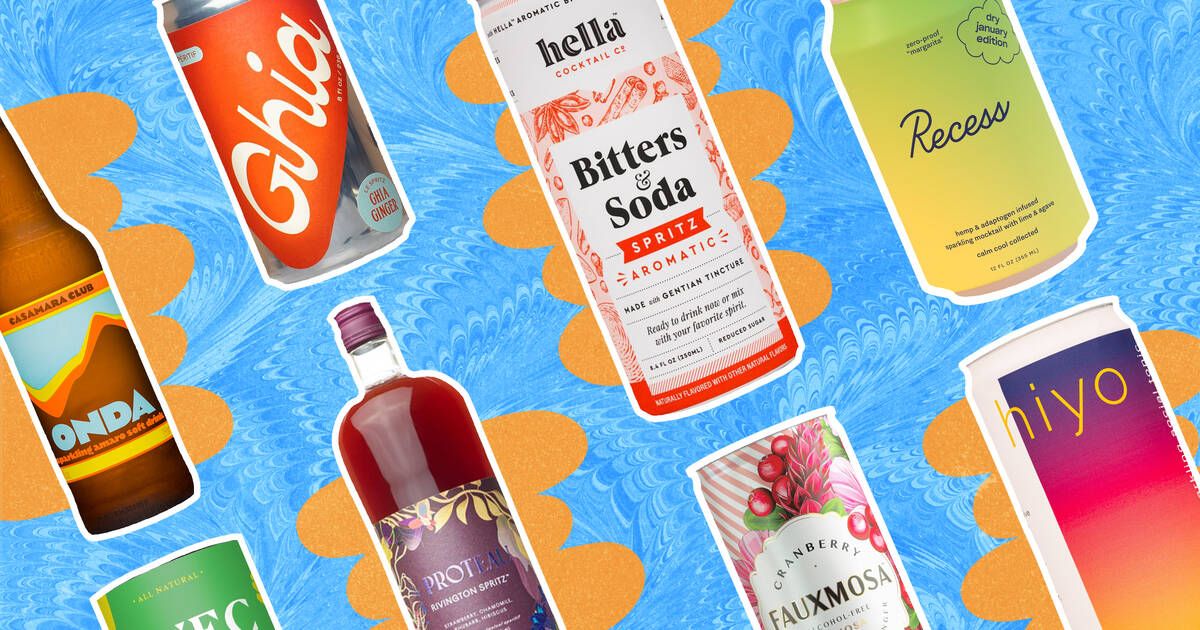Sip in Style: Exploring the Flavorful World of Non-Alcoholic Beverages
When it comes to beverages in the USA, the choices are as diverse as the nation itself. While alcoholic drinks have traditionally taken the spotlight....

Introduction
When it comes to beverages in the USA, the choices are as diverse as the nation itself. While alcoholic drinks have traditionally taken the spotlight, there's a vibrant and rapidly growing trend that's capturing the taste buds of many: non-alcoholic beverages. From refreshing mocktails to health-conscious elixirs, the world of non-alcoholic drinks offers a delightful array of flavors, aromas, and experiences that cater to all palates.
Rise of the Mocktail Culture
The surge in mocktail culture within the United States finds its roots in the preferences of Generation Z and Millennials, driven by a decline in alcohol consumption. In an environment where the nonalcoholic beverage sector is experiencing rapid expansion, the allure of mocktails has surged in popularity over the recent five-year span, a revelation uncovered by NielsenIQ's research. This momentum has been spurred by the ascent of wellness culture and a reduced fascination with alcohol, extending to individuals who aren't necessarily embracing a sober lifestyle. A significant player, Athletic Brewing, a nonalcoholic brewery, witnessed an extraordinary revenue surge, boasting an incredible 13,000% increase from its inception in 2018 to 2021, a transition that saw their production escalate from 875 barrels in the first year to a remarkable 170,000 barrels in 2022. A novel contender in this landscape, Ritual Zero Proof, a nonalcoholic spirit company, confidently asserts that their drinks replicate the nostalgic "burn" reminiscent of alcoholic beverages. Marcus Sakey, the co-founder of Ritual Zero Proof, boldly states that their innovation is "revolutionizing the drink of the summer."

These mocktails and their alcohol-free alternatives are far from transient trends; they're shaping a substantial sector. According to Global Market Insights, the industry is poised to expand by a remarkable $30 billion by 2025. The social media landscape on platforms like TikTok further solidifies their resonance, with the hashtag #mocktails amassing an astonishing 1 billion views. Supporting this surge, Nielsen data underscores the impact, highlighting a significant $395 million in total dollar sales of these beverages between August 2021 and August 2022. As the wave of mocktail culture continues to crest, it's clear that this transition is more than just a nod to healthier choices—it's indicative of a broader transformation in consumer inclinations, defining a palatable and enduring trajectory for the world of nonalcoholic delights.
Health and wealthness Elixer
The realm of non-alcoholic beverages is embracing a captivating trend that blends wellness with indulgence. A variety of companies are offering health elixirs infused with adaptogens—herbs, botanicals, and mushrooms renowned for their stress-relieving and mood-enhancing properties. Leaders in this movement include Kin Euphorics, known for craft non-alcoholic elixirs featuring mood-adjusting adaptogens, botanicals, and brain-boosting nootropics. Hiyo stands as another contender with mindfully crafted canned drinks containing organic adaptogens and natural nootropics for a better-than-alcohol experience. Seedlip, the original distilled non-alcoholic spirit, offers cocktail alternatives with zero sugars and calories. This trend caters to both flavor enthusiasts and wellness seekers, merging taste and health in a captivating fusion.
Cultivating Crafted and Curated Flavors
The art of creating distinctive and curated flavors in non-alcoholic beverages involves a meticulous process of selecting and harmonizing ingredients to achieve truly exceptional and delightful tastes. This can encompass the use of natural elements like herbs, spices, fruits, and vegetables, or even the incorporation of lab-crafted artificial flavors.

The trend toward 'sober-curious' lifestyles has ignited innovation across various non-alcoholic categories, spanning carbonated soft drinks (CSD), sparkling waters, ready-to-drink mocktails, and beyond. Consumers continue to seek the elevated experience associated with skillfully crafted cocktails, prompting the emergence of intricate mocktails. These novel concoctions ingeniously combine beloved citrus and fruit flavors with daring botanical and floral undertones, seasonal ingredients, aromatic spices, and fresh herbs.
For instance, Atera NYC has introduced a 'Temperance Pairing' to their menu, offering reimagined mocktail renditions of conventional cocktails. Among them is the inventive "Nogroni," a playful take on the classic negroni, featuring a blend of juniper saffron water, raisin nectar, non-alcoholic bitters, and quinine bark. Meanwhile, Fellow in Los Angeles tantalizes patrons with a range of meticulously crafted mocktails, including the enticing "Falooda." This alcohol-free delight blends watermelon, holy basil seed, rose, and mint flavors into a harmonious symphony for the senses.
Elevating the Dining Experience
As the number of individuals opting to abstain from alcohol or reduce their consumption continues to rise, the importance of enhancing the dining experience for non-alcoholic beverage drinks becomes increasingly evident. Restaurants and bars that provide a diverse selection of top-tier, captivating non-alcoholic options can capitalize on this trend, catering to a wider customer base and reaping financial rewards.
An effective strategy for elevating the dining experience involves establishing a comprehensive non-alcoholic beverage program. This entails offering a thoughtfully curated array of non-alcoholic drinks that are not only rich in flavor but also designed to complement food, much like how cocktails are artfully paired with culinary creations. By extending this attention to non-drinkers, establishments can convey a commitment to community health and a dedication to staying attuned to contemporary preferences.
Another avenue for elevating the dining experience entails offering an extensive range of both no- and low-alcohol beverage choices. This spectrum can encompass an assortment of beverages, spanning beer, wine, spirits, seltzers, mocktails, and even champagne. As health-conscious consumers increasingly seek refreshing, gratifying, and full-flavored alternatives to traditional alcoholic options, providing these diverse choices can elevate the overall dining experience, enticing a wider array of patrons and aligning with evolving consumer preferences.
Inclusivity and Social Trends
The ascent of non-alcoholic beverage drinks is closely intertwined with the prevailing themes of inclusivity and evolving social dynamics. The younger generation, particularly Gen Z, is demonstrating a reduced interest in alcohol consumption compared to previous cohorts, prompting the rise of a widespread wellness movement. This wellness trend is not confined to any specific age group; people from all walks of life are increasingly prioritizing self-care.

Reflecting the growing momentum of non-alcoholic beverage trends, sales are on a robust upward trajectory across the United States. Over the period between August 2021 and August 2022, the total dollar sales of non-alcoholic drinks reached a significant $395 million, showcasing a substantial year-on-year growth of +20.6%. This surge is driven by a multitude of factors, prominently health-consciousness, which now supersedes influences like cost or peer pressure when it comes to purchase decisions.
Inclusivity emerges as a paramount aspect in the non-alcoholic beverage movement. The provision of a diverse array of top-tier, enticing non-alcoholic beverages is not just a means to accommodate non-drinkers, but also a savvy business practice for restaurants and bars. This strategic approach not only caters to abstainers but also conveys an establishment's commitment to community health and alignment with contemporary trends. As inclusivity and health-consciousness increasingly shape consumer preferences, the ascent of non-alcoholic beverages becomes more than just a trend; it's a transformative shift reflective of a broader societal transformation.
Conclusion
The evolving landscape of beverages in the USA is a reflection of the nation's diversity and shifting preferences. While alcoholic drinks have traditionally held the limelight, a dynamic and rapidly growing trend is captivating palates across the country: the rise of non-alcoholic beverages. From invigorating mocktails to wellness-focused elixirs, the world of non-alcoholic drinks offers an array of flavors, fragrances, and experiences that cater to a wide range of tastes and choices. This movement is driven by the preferences of Generation Z and Millennials, who are increasingly embracing a sober-curious lifestyle, as well as a broader wellness movement that resonates with all age groups. As the surge in mocktail culture intertwines with health-driven innovations, the realm of beverages is undergoing a transformative shift, shaping a future where flavor, inclusivity, and well-being are at the forefront of every sip.




